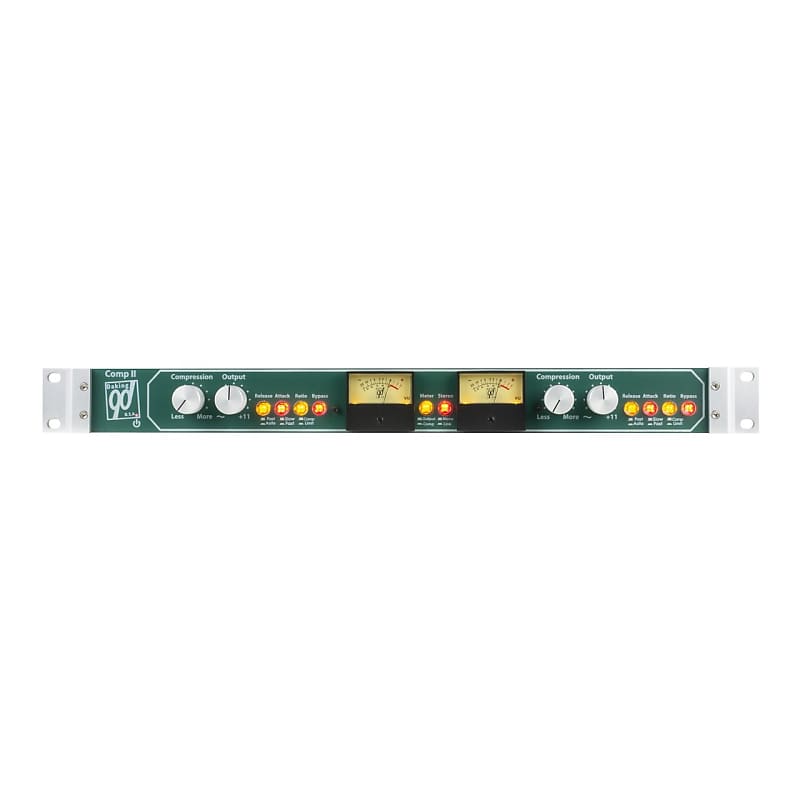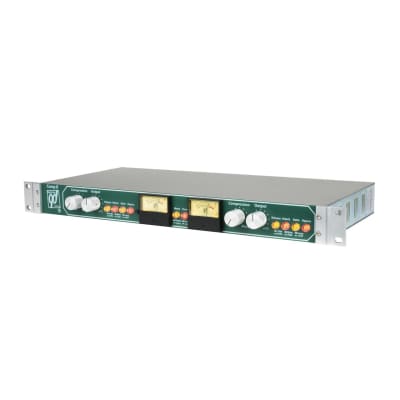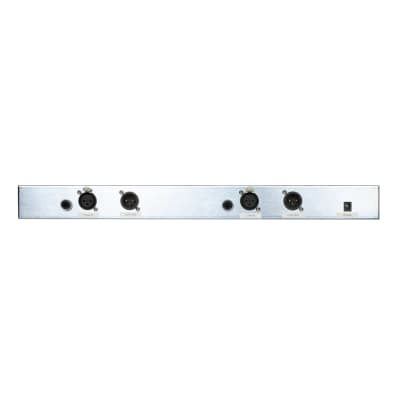This new dual mono stereo linkable VCA compressor from Geoff Daking is ready to carry your project from tracking to final mixdown in one box!
The Daking COMP II is a handmade compressor/limiter designed to be easy to use and sound like much more expensive comp/limiters. Built right here in the USA, it offers better sounding compression on all kinds of sources in the studio. Whether in the hands of a highly experienced engineer who needs fast workflow, or a novice who is not sure how to best set up a compressor, the COMP II gives professional results without a big learning curve.
With big old-style analog meters and a simple setup, the COMP II is easy to understand and easy to use. Designed carefully by Geoff Daking and Dave Thibodeau to behave well on a variety of real in-studio applications, it may challenge your notions of how good a two-knob compressor can be.
The two channel, electronically balanced COMP II, can operate in dual mono or stereo linked mode for a beautiful stereo image. In dual mono it acts like two independent mono compressors for use on two different - perhaps unrelated - sources. There is no master channel in stereo mode. Each channel retains its independent control.
The variable parameters of the COMP II are:
- Threshold: Determines the level at which the compressor begins to work.
- Ratio: The slope of the gain reduction. Compress is a low ratio good for general gain reduction, while Limit presents more of a “brick wall” to the signal.
- Attack: The speed with which the compressor begins to react. Slow allows transients, like the attack of drums, to pass while compressing the back end. Fast will remove transients.
- Release: Determines how quickly the compressor “lets go”. Fast is self-explanatory. Auto reacts to both the level of the signal and it’s duration. Small peaks will release quickly, while long and loud signals will release much more slowly.
Combinations of Attack, Release and Ratio will create different effects. The most natural will be Compress•Slow•Auto. The most aggressive will be Limit•Fast•Fast.
Make-up Gain: Compensates for any gain lost in compression. For serious rock stars, note the
output goes to 11!
Why it’s Different: The Daking Comp II is a complex design that employs a unique method of gain reduction using a VCA like a FET. This maintains the unique Daking sound of our legacy compressors. Unlike most VCA designs, ours uses feedback gain reduction, a peak detector and an all-discrete Class A follower.
The outboard power supply makes sure this unit is quiet and usable around the world on any voltage. Switches are illuminated, making it easy to see what’s “on” in a dark room. The rear panel offers XLR electronically balanced inputs and electronically balanced XLR/¼” TRS outputs.
Purely analog, it’s so easy to get a sound you love. This compressor may easily become your favorite.
Specifications
- Input: XLR (x2)
- Output XLR (x2), TRS (x2)
- Differential input and output amps
- Class “A” amplifier for make-up gain
- All metal construction with stainless steel chassis for noise immunity
- Custom aluminum knobs
- Power supply included
- Frequency response: 20Hz-65kHz
- THD at +4dBu input and no compression at 1kHz: Typical 0.02%, Max 0.035% (22-22kHz, Un-Wtd)
- THD at +4dBu input and 2dB of compression at 1kHz: Typical 0.02%, Max 0.035% (22-22kHz, Un-Wtd)
- Noise: less than -80dBu, 22-22kHz
- 1U 19” rack-mount
- Unit weight: 5.35 lbs (2.45 kg)
- Unit dimensions: L front: 19in (48.26cm) L rear: 17in (43.18cm) W: 8.375in (21.27cm)
- H: 1.625in (4.13cm)
- Box weight: 8.70 lbs (3.95 kg)
- Box dimensions: L: 29in (73.66cm) W: 14 in (35.56cm) H: 6 in (15.24cm)
Specifications are subject to change without notice.




